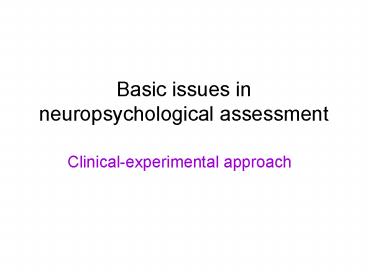Basic issues in neuropsychological assessment - PowerPoint PPT Presentation
1 / 17
Title:
Basic issues in neuropsychological assessment
Description:
Neurological assessmet for evaluation of consciousness and general mental state ... Incomprehensible sounds. ( Moaning but no words.) Inappropriate words. ... – PowerPoint PPT presentation
Number of Views:380
Avg rating:3.0/5.0
Title: Basic issues in neuropsychological assessment
1
Basic issues in neuropsychological assessment
- Clinical-experimental approach
2
- Neurological assessmet for evaluation of
consciousness and general mental state - Glasgow Coma Scale
- Mini-Mental State Examination
3
- Clinical-experimental approach
- Lurias diagnostic evaluation
- Examples of other neuropsychological
investigations in reference to Luria (A.L.
Christensen, M. Maruszewski) - K. Goldstein and M.Scheerer evaluation of
concrete vs abstract behaviour
4
- Psychometric methods
- Luria-Nebraska Neuropsychological Battery (LNNB)
- Halstead-Reitan Neuropsychological Battery (HRNB)
- Right Hemisphere Language Battery (RHLB)
5
Glasgow Coma Scale
- Best eye response (E)
- There are 4 grades starting with the most severe
- No eye opening
- Eye opening in response to pain. (Patient
responds to pressure on the patients fingernail
bed if this does not elicit a response,
supraorbital and sternal pressure or rub may be
used.) - Eye opening to speech. (Not to be confused with
an awaking of a sleeping person such patients
receive a score of 4, not 3.) - Eyes opening spontaneously
6
Glasgow Coma Scale
- Best verbal response (V)
- There are 5 grades starting with the most severe
- No verbal response
- Incomprehensible sounds. (Moaning but no words.)
- Inappropriate words. (Random or exclamatory
articulated speech, but no conversational
exchange) - Confused. (The patient responds to questions
coherently but there is some disorientation and
confusion.) - Oriented. (Patient responds coherently and
appropriately to questions such as the patients
name and age, where they are and why, the year,
month, etc.)
7
Glasgow Coma Scale
- Best motor response (M)
- There are 6 grades starting with the most severe
- No motor response
- Extension to pain (abduction of arm, internal
rotation of shoulder, pronation of forearm,
extension of wrist) - Abnormal flexion to pain (adduction of arm,
internal rotation of shoulder, pronation of
forearm, flexion of wrist) - Flexion/Withdrawal to pain (flexion of elbow,
supination of forearm, flexion of wrist when
supra-orbital pressure applied pulls part of
body away when nailbed pinched) - Localizes to pain. (Purposeful movements towards
painful stimuli e.g., hand crosses mid-line and
gets above clavicle when supra-orbital pressure
applied.) - Obeys commands. (The patient does simple things
as asked.)
8
Interpretation
- Generally, brain injury is classified as
- Severe, with GCS 8
- Moderate, GCS 9 - 12
- Minor, GCS 13
- Individual elements as well as the sum of the
score are important. Hence, the score is
expressed in the form - "GCS 9 E2 V4 M3 at 0735".
9
Mini-Mental State Examination
- The MMSE test includes simple questions and
problems in a number of areas - the time and place of the test
- repeating lists of words
- arithmetic such as the serial sevens language use
and comprehension - basic motor skills.
10
Interpretation
- Any score over 27 (out of 30) is effectively
normal. - Below this, 20-26 indicates some cognitive
impairment - 10-19 moderate to severe cognitive impairment
- Below 10 very severe cognitive impairment
11
Neuropsychological assessment
12
Lurias diagnostic evaluation
- Terms of functional systems (blocks) and primary
secondary and third-rate brain areas - Part of A.R. Luria's legacy was the premium that
he placed on the observation of a patient
completing a task intraindividual differences
13
Anne-Lise Christensen
- Lurias Neuropsychological Investigation (1975)
- Preliminary conversation
- Motor functions
- Acoustico-motor organization
- Higher cutaneous and kinesthetic functions
- Higher visual functions
- Impressive speech
- Expressive speech
- Writing and reading
- Arthmetical skills
- Mnestic processes
- Intellectual processes
14
K. Goldstein and M. Scheerer
- Abstract and Concrete Behavior. Experimental
Study With Special Tests (1941).
15
K. Goldstein and M. Scheerer
- The Goldstein-Scheerer Cube Test
- The Gelb-Goldstein Color Sorting Test
- The G.G.W.S. Object Sorting Test
- The Weigl-Goldstein-Scheerer Color Form Sorting
Test - The Goldstein-Scheerer Stick Test
16
Luria-Nebraska Neuropsychological Battery (LNNB)
- motor functions,
- rhythm,
- tactile functions,
- visual functions,
- receptive speech,
- expressive speech,
- writing,
- reading,
- arithmetic,
- memory,
- intellectual processes,
- pathognomic,
- left hemisphere and
- right hemisphere.
17
Halstead-Reitan Neuropsychological Battery (HRNB)































